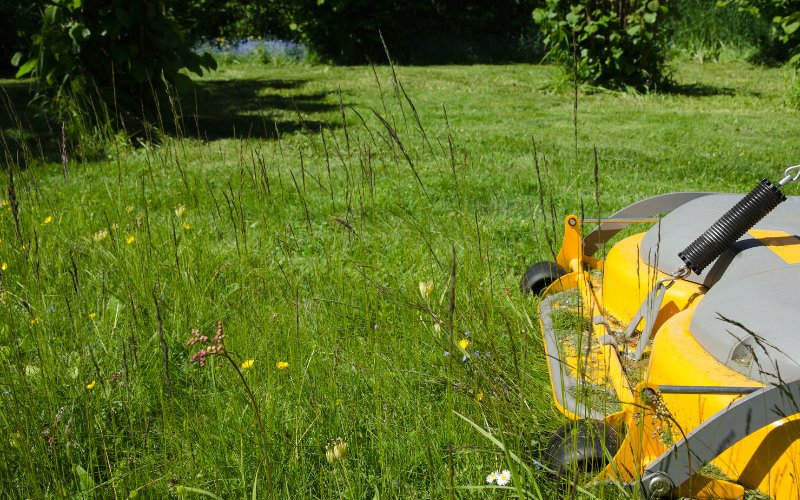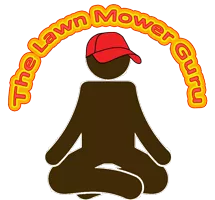Even though riding mowers usually have a deck that raises pretty high, it’s not always enough. Consequently, you may be looking around to find ways to gain a couple more inches. We’ve all heard of bizarre methods devised in garages across the country that claim to work. Unfortunately, as a result, so have the medics in the emergency room.

Reasons Why You Should Not Raise a Riding Mower Deck That is Not High Enough
Riding lawn mowers are hazardous pieces of equipment and shouldn’t be modified or operated outside the designed parameters. Additionally, you’ll risk damaging your equipment and have to pay for avoidable repairs.
Altering the Center of Gravity
One of the factors you contemplate when purchasing a new lawn mower is its capabilities. The new Husqvarna TS 354, as an example, has a maximum 15degree slope limit. However, the moment you raise the deck beyond the factory settings, you reduce the limit.
You might think this doesn’t apply to you as your yard is flat, but the increased height also affects cornering. If you take a corner too fast, you’ll feel the mower wanting to topple over. By maintaining the deck height within the mower’s range you’ll have a stable ride by keeping the weight low to the ground.
Displacing the Deck Belt
Cutting with a deck that is raised higher than it should be will lead to premature wearing down of the deck belt. In addition, the belt won’t run as intended even when the deck is raised in the storage position.
As a result, the belt will make contact with the pulleys at an awkward angle. The excessive friction against the pulley flanges will burn down the sides of the belt and possibly cause the belt to snap or, at the very least, stretch out.
The Deck Skirt Will Provide No Protection
The deck’s skirt keeps the grass in and toes out. Decks are designed to hug the grass and create a seal to keep the inside and outside separated. Raising the deck beyond the specified cut heights eliminates this means of protection.
Any rocks you mow over may become lethal projectiles with unimaginable consequences. For example, the Craftsman 50″ deck’s high-strength steel construction withstands the enormous impacts of flying rocks. Unfortunately, your body does not.
An Alternate Option to Raising the Lawn Mower Deck
What about bigger tires, I hear you ask. This is a definite NO. Just as the deck has working parameters, so do the wheels and tires. So not only will increasing the tire size affect the center of gravity, but it will also affect the lawn mower’s performance.
All tractor mowers and zero-turns have a restriction preventing these types of modifications. A zero-turn uses a yoke mount on the front wheels, so there’s no room to increase the size of the tire. Additionally, tractor mowers have wheel arches and mudguards with sufficient space for the mower to move fluidly. Reducing these areas will ultimately cause oversized tires to rub and damage the mower’s structure.
Other downsides to this modification are that bigger tires will tear up the grass, strain the engine, and void any warranties.
A Few Ideas of What You Could Do Instead
My first question is, how high are you trying to cut the grass? The majority of grasses only need to be cut 2-3 inches tall, which all ride-on mowers should easily accommodate.
If you have just switched from a walk-behind to a ride-on, you may find that the grass is much thicker than you’re used to. Grab a tape measure and check the thickness of the grass cut by the walk-behind compared to the thickness of the ride-on’s cut.
Because of its lightweight body, the walk-behind was likely sitting on top of a few inches of grass thickness. Now that you’re cutting with a much heavier mower, you’ll probably find that the mower’s wheels sink further down onto the dirt. Consequently, when compared to a walk-behind, the ride-on mower will appear unable to cut high enough and be too low.
Reduce the Overall Height of the Lawn
Try lowering the overall lawn height with the lawn mower. Reducing the height of the lawn can be difficult as it will, unfortunately, result in scalping the grass. I’d suggest doing this on a small section to see how the lawn reacts. I’d pick just a foot or two of the yard hidden out of sight if possible in case it doesn’t come back. Some lawn grasses like St. Augustine don’t take kindly to being scalped, so be very careful.
Cut the Lawn in Narrower Strips
If you’re tackling overgrown grass and the mower struggles to cope with the sheer volume of grass, you could try to cut in narrower strips. Mowing with half of the deck will create half the clippings.
Also, if your mower has a discharge chute, then make sure it’s fully open so that the blades don’t get bogged down trying to mulch the excessive clipping. Finally, remember to discharge the clipping towards the already cut grass and not onto the uncut grass, as that will make it even harder to cut.
Try Using a Weed Wacker
If your lawn is too tall for the last method, I suggest using a weed whacker to reduce the height before you get on your riding mower. Weed whacking will take extra time, but it will get the job done.
Have a Professional Reduce the Height One Time
Alternatively, if you feel like your riding mower deck is not high enough, you could have the lawn cut once by a professional with a more powerful mower who can get it to the height you need with less difficulty. And from there, the length of your grass will be manageable for the cut height specifications that your riding mower allows.


I really enjoyed this article. I own a Husqvarna YTH24V42 lawn tractor and I live in Charlotte, NC. Here, they recommend a cut height of around 3″, but this mower cuts lower, even when set on “6”, which is the highest deck setting. I’m glad I read your article, because I have to admit that I have considered some of the things you warn against. I guess there really is no “mower” solution; however, we have installed an irrigation system, and I’m also letting the grass grow a little longer, before I cut. Between that and some natural treatments, including Heritage G for fungus, our lawn seems to be happy – so far.
I wish the manufacturers would publish the min and max height of their riding mowers. I have one riding mower I can’t use because it cut to low.
Thanks for the articles you posted.
Hi Lee,
Sorry to hear that you have this issue.
Unfortunately, manufacturers all use numbers on their cut height that don’t really stand for anything. Or at least nothing that is easily relatable to our lawn.
Hopefully, you can return the lawn mower.
Thanks for the comment.
Tom.